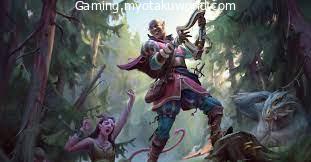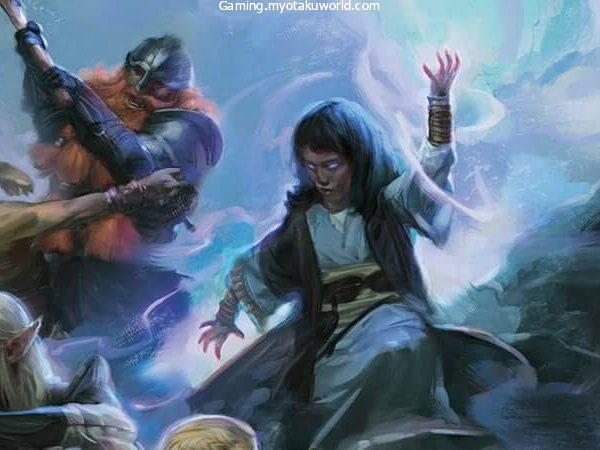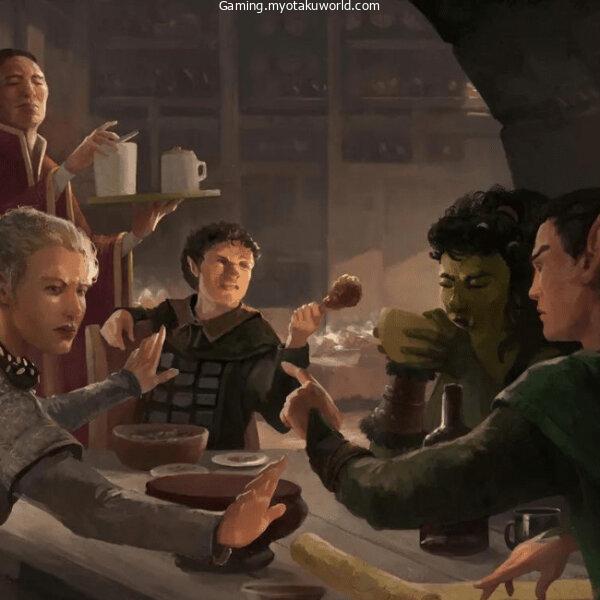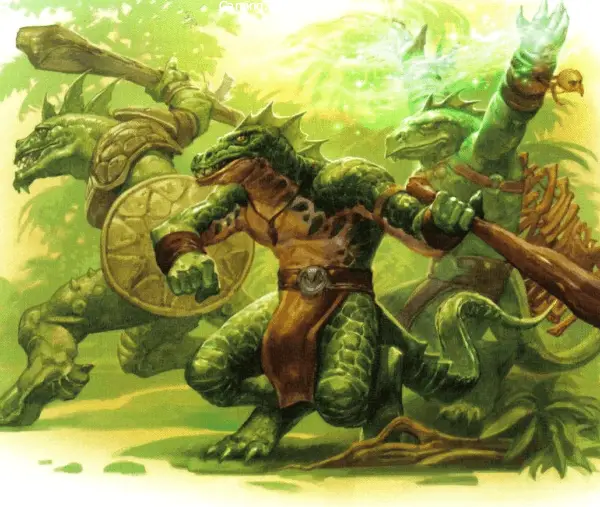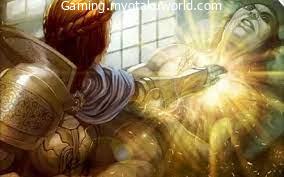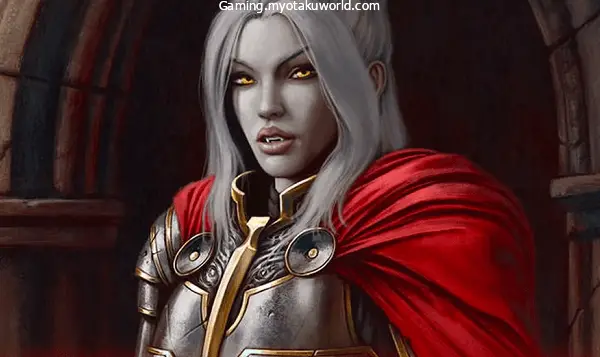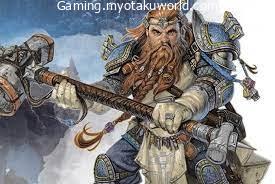The time has come for Night of the D&D It’s D&D night, and Seymour the rogue has hidden behind an obelisk with a threatening look, waiting to strike an Arcanaloth who is flying across the battlefield.
The blade is hurled at the enemy and attacks with an advantage. However, he will roll two and nine when he rolls the dice.
After adding the modifiers, the result is a 16-to-hit. Seymour must wait for this attack to hit to inflict an attack that sneaks in and save his sane allies from being on the other side of where this creature is moving toward.
A voice from over the table utters “You have inspiration!” Seymour can hear this, and he grabs an additional die. He rolls it and then increases his attack roll to 21.
“That hit,” said the DM. The table roars with joy, and Seymour begins rolling his damage.
What has transpired? What can this rogue do to increase their attacking power? Who was this mysterious and beautiful voice that came out of the other side?
This is the question that lies at the heart of the most prestigious support class and the most well-known feature of it: its bardic inspiration.
Continue going through the Bardic Inspiration 5e Guide to discover all you must learn about this talent.
What is Bardic Inspiration?
Bardic Inspiration is a skill that bards have at the beginning of their level. This ability lets you make use of bonuses to invite a friend that is located within 60 meters of you. This will provide them with a small benefit to rolling a d20 within the next 10 minutes of gameplay.
The person who receives it will be able to decide the time and date they will use it for. When your ally has used it, the die has been discarded and it cannot be used again.
The bonus they earn is the die number die of d6. The die, however, becomes larger as you advance as a bard. When you reach the 5th level, it is an 8; at the 10th level, it’s a d10; and at the 15th stage, it is a 12.
This is the specific number of levels you can attain as a bard. If you’re multiclass and have a multiclass character, you may be a character with a 10th level. However, you only have 5 bar levels. So, your bardic inspiration die will still be the 8-sided die.
Every day you start with a set of bardic inspirations that are equal to the charisma modifier. For instance, if you have a Charisma rating of 17, Your modifier is 3. This means you can motivate people three times. The time you’ve spent on them is refreshed after a long time of rest.
One of the most important aspects of this idea is that your friend can decide to get the bonus roll after they’ve rolled their d20 and before they are deemed to be a success or an error. On certain roles you may already be aware of the purpose or your DM could inform you.
For instance, after a couple of rounds of combat, you could be able to discern an opponent’s AC by looking at what they’ve failed and what’s failed to hit. D&D spells such as Counterspell can set DCs once you cast them and can tell the probability that you’ve completed.
When your friends decide the things they will use as sources of inspiration, you need to be aware of what they could apply it to since they don’t have all the features of your class memorized. Here are the best methods to utilize bardic inspiration.
Attack Roll

The rogue within your group rolls an attack roll. The result is 14. Before the DM announces to the table whether or not the attack has hit the opponent, the rogue has the option to roll a d6 to add that result to the 14, possibly reaching up to 20.
Bardic inspiration to make attacks is the most frequent usage of this option at lower levels, where you’re focused on completing more attacks than your adversaries.
Make use of this feature primarily for allies that have one attack with high damage, such as a rogue or a ranger. Classes such as monks depend on making multiple attacks, and their damage output is spread across.
Because bardic inspiration can only influence one role, you will not be able to significantly help. Classes like the cleric may serve as strikers with powerful damage-inducing attacks such as Inflict Wounds and Guiding Bolt.
It’s crucial to recognize how your group members can communicate your motivation effectively.
Bardic inspiration is also a good way to make everyone at the table feel like a player in your game. Nobody likes going to play D & D and failing to complete each attack for the duration of the week.
If someone is playing particularly poorly, motivate them to make sure they make their attack successful and accomplish something exciting. As bards, you have an excellent opportunity to help each of the characters playing the game and the other players.
Ability Check
Any ally that has been inspired may add your bardic inspiration bonus to any ability check within the prescribed time.
Ability checks can include any ability check and checks to open doors and locate traps. There are a variety of checks players can perform in D&D.
The problem with using a bardic inspired ability test is that it’s difficult to understand what the consequences of failure to a check will be.
Does failing an athletics test to leap over a crevasse mean your character is going to plunge to death or is it a sign that you’ll have a grip on the edge and have another chance to get yourself back up?
Another issue with applying inspiration to ability tests is that it occurs in the absence of combat and there is a possibility of running overtime.
Bards want their ideas to be utilized as well. If you’re navigating in the wild for hours, it can be difficult to determine what period of time is best to draw inspiration from, whereas most combat scenarios take less than a minute.
You can encourage the cleric to enhance their flaunting armor when they make stealth checks. You can inspire the wizard planning to employ Counterspell and who needs to conduct an ability check for it to work.
You can inspire the rogue or the druid whenever you feel you’re about to engage in combat to allow them to make use of their inspiration when they initiative roll and be first into combat. Initiative rolls are checks for dexterity, so bardic motivation can be added to them.
Saving Throws
Saving throws are used less frequently than attack rolls or ability checks. If you’re required to make a saving throw, you’ll want to be successful.
Making a mistake on a saving throw can be a sign that you are subjected to the most powerful effects of spells and conditions, such as being paralyzed or restrained or taking double the amount of damage.
Through the use of bardic inspiration, encounters with spellcasters or creatures that could cripple, frighten, or expose the participants to a variety of negative effects can be greatly reduced.
If you can inspire someone to inspire them before they fall unconscious, they could apply your bardic inspiration to their life-saving role, which could save their life!
When you encourage someone else, you may have an idea in the back of their mind about how they should make use of it. You may even suggest the purpose for which they should keep the money.
But ultimately, it’s the player’s decision when they decide to use it. It could be a way to encourage the barbarian to include the bonus on their attack roll, but they prefer to use it for a grapple check.
Magical Inspiration (TCoE)
This is an option that was introduced by Tasha’s Cauldron of Everything. It allows an ally to make use of the bardic influence you’ve provided them with to increase the healing or damage caused by the spell they’ve cast.
It’s only available to one target for the spell, and you can’t include it in every mass. The Healing Word is similar.
It’s essentially three additional damage points or points for healing. When you consider the other benefits of the bardic influence, it may not be worth the cost of the dice.
Font of Inspiration
After you have reached the 5th level of bard, you can regain the full use of inspiration from bards after a brief rest instead of a long break.
The game assumes that you’re taking two rests a day. This effectively doubles the number of times you can use it every day.
Superior Inspiration
The capstone of the bard’s feature. When you reach the 20th level, you get one more use of bardic inspiration whenever you roll initiative and you aren’t able to use bardic inspiration.
It’s not the most exciting feature that caps off your game, but it also means there’s always at the very least one bardic inspiration available.
Additional Uses of Bardic Inspiration

Beyond the fundamental applications of bardic inspiration, every bard class has its own specific use of this power source.
Certain abilities are logically based when you can simply inspire others to try harder.
Some, however, make use of bardic inspiration only as a way to control it along with other functions, as well as to create it to appear as if it’s a bard skill, even though it’s really not.
The College of Lore Bards (PHB)
Lore bards are granted the ability to cut words. This allows you to utilize reactions to subtract the roll using your bardic influence from an opponent’s attack roll, ability check, and damage roll. Most of the time, this can be employed to make enemies not attack.
Cutting Words isn’t affected by the game of guessing what to add to attack rolls, as you have ACs for your entire group and the DM will usually announce the roll they made to be hit.
The feature doesn’t permit you to subtract from an opponent’s saving throw. Even without this feature, this is an extremely powerful feature.
However, it’s not effective when the enemy is unable to hear your voice or isn’t capable of being lured, which is the majority of monsters that are in the game.
Lore bards can also acquire the Peerless Skill at the 14th level, which allows you to add bardic inspiration to any ability check you make.
Since you’re not able to normally draw bardic inspiration for yourself, this is an excellent capability to use in an initiative roll or counterspell.
The College of Valor Bards (PHB)
The Valour Bards are a martial arts-focused group and have an ability called Combat Inspiration. This ability has two purposes.
First, it allows your allies to include their bardic influence in the damage they roll by using weapons.
The second one is that your allies can make use of the reaction of their opponent to boost Bardic inspirations to the AC when they are attacked.
The first game gives you an increase of a tiny amount to the damage output of your ally. As the boost adds damage, the damage will be increased by an important hit, making it a great option to get additional damage.
The other use of the ability can be described as a less effective version of the bard of lore’s Cutting Words. It is assumed that you have already inspired that character, and they have to use their reaction to increase their AC.
The benefit is that there’s no restriction on the species it can be used against. If used properly, it will keep your front liner’s limbs alive.
College of Glamour Bards (XGtE)
Glamour bards are granted their ability to wear the mantle of inspiration. This ability is a bonus action, allowing you to grant friends temporary hits and slow down their speed without creating opportunity attacks. The number of people that you can influence is proportional to the charisma modifier.
Every ally receives 5 hit points for each temporary period, and they increase this following the level you are at. As you progress to the 5th level, they gain 8 HP for a short period of time, 11 at the 10th, and 14 at the level of the 15th.
This ability can completely alter the direction of the battle. It is possible to add a minimum of fifteen hit points to your squad, and a maximum of 70 hit points for higher levels.
Allowing your allies to reposition themselves on the field can help get your troops out of harm’s way, or create a formidable attack sequence in the next turns. Furthermore, this ability requires one bardic influence.
College of Swords Bards (XGtE)
Sword bards focus on martial arts and acquire Blade Flourishes at the 3rd level. This skill lets you make the bardic inspiration take on additional damage.
You can choose to either
A) increase your AC through the roll
or
B) also inflict damage on opponents in the vicinity by forcing your opponent back and continuing to follow them when you wish to.
In comparison with other subclasses’ use of inspiration from bardic sources, this can be a bit tinny.
In addition, boosting your AC or causing damage to several enemies is a good idea if you’re heavily outnumbered. You could also opt for the Dodge move instead.
College of Whisper Bards (XGtE)
Whisper Bards gain the ability to create psychic blades. This ability lets you make use of a bardic influence to inflict an additional 2d6 damage on an attack with a weapon.
Although College of Swords bards are restricted to using the blade, this feature can be used with ranged attacks too.
The damage is based on your level and is similar to a rogue’s sneak attack. The damage from psychics is not easily blocked, which makes it a much more efficient source of damage. It is also possible to become more efficient with spells.
The College of Creation Bards (TCoE)
The bards who create are granted mote of potential that adds additional effects to the primary applications of bardic inspiration, based on the kind of d20 roll the inspiration is applied to.
If added to an attack roll, the person who is the target of the attack must be successful in the Constitution saving throw or suffer thunder damage equivalent to the roll. If you add it to a test, an ally’s roll is allowed.
Giving advantage when rolling the bardic inspired roll If you add it to a saving throw, the ally receives temporary hit points equivalent to the role of the die plus the charisma modifier.
They’re all fantastic bardic effects that don’t require any extra work to make use of.
The College of Eloquence Bards (TCoE)
The College of Eloquence bards are constructed around the reliability and strength that their inspiration comes from bards.
First, you get unsettling words that allow players to use a roll of bardic influence as a bonus move to subtract it from the next saving throw they make during the round. You can follow this up with a power save or sink spell for maximum impact.
Additionally, you receive Unfailing Inspiration, which allows your companions to keep the inspiration you gift them, even if they attempt to use it and it doesn’t work.
The biggest issue that your fellow bards encounter when it comes to bardic motivation (besides not remembering to utilize it) is that they roll so little that they have to use the highest number of numbers on the die to win.
Then they can roll and, if they don’t succeed in making it, they’ll continue to roll the die and attempt again.
Finally, if your ally makes use of their bardic influence and succeeds by a certain amount, you can use your reaction to provide an ally with a second motivation without having to sacrifice one of your benefits.
This is possible by several times that are equal to the charisma multiplier, which at the 14th level is five times. This gives you five additional uses of inspiration from bards every day.
College of Spirits Bards (VRGtR)
Spirits bards acquire the ability to tell tales From Beyond. You call out to spirits who are dead, who can tell stories through you.
In addition, you may make use of your bardic inspiration to study a specific story from the ether, according to the Spirit Tales table in VRGtR.
When you are tired when you’re done, you’re able to relay that story to another animal, which will be able to benefit from its effects.
These effects consist of bardic inspiration upon every mental ability test for 10 minutes and dealing massive damage to the target. As your bardic dice increase in size, they will be able to roll more powerful effects, such as striking or incapacitating creatures.
Although this skill is not random in the sense that you roll to see what outcome you receive but you will be aware of the tale you’ve loaded before unleashing it, which allows you to plan your strategy accordingly. At the 14th level, you can play the table two times and select the option you prefer.
Bardic Inspiration Using Practical Advice
Between the fundamental abilities and subclasses’ features, there are a variety of ways to draw inspiration from bards.
Alongside casting spells, this is an essential part of performing as a bard with a high level of skill, which is why you should perform as well as you can.
Here are some suggestions to draw inspiration from your bard:
- Remind the party. It could be an inspiration, but the guests are likely to forget about the motivation you provided them with. It’s not because they’re not grateful, and it’s not your fault. They’re just overwhelmed with the myriad of things they’re trying to track. Most likely, you’ll have to remind the members of your group that they’re not alone. die.
- Use actual dice. If you’re playing live, ensure you have the right number of dice before you to are your bardic, the inspiration dice. If you’ve inspired someone else, give the dice to them to remind them they are not alone and to keep track of your personal resources. If you’re playing on the internet, you can place dice in your hands to serve as visual reminders of how many are left.
- Be aware of your actions. Keep in mind what actions you perform. Making use of an extra action that you can use to inspire bards means you’ll be unable to cast a healing word. When lore bards are deciding whether to cast Cutting Words and when to keep their reaction to Counterspell This is also useful when you’re trying to decide what feat you should choose and how you can multiclass. For instance, it’s the telekinetic feat that utilizes your bonus action frequently. Although it’s interesting thematically, it’s not in line with your abilities currently.
FAQs
What can I add bardic inspiration to?
You can add an inspiration die from a bardic game to one check of ability, such as an attack roll or save throw, in the first 10 minutes after you receive it. Bards with Valor let you add to damage or your AC, and AC, as well as Creation bards, can have other effects that depend on how you utilize them.
Can you get more bardic inspiration?
Two primary methods to boost your bardic inspiration are to boost your charisma score as well as increase your level. There are a variety of applications that are equal to that modifier for charisma. This increases your opportunities. As you advance in level, each die gets bigger in size. At the 5th level, your options are refreshed after a brief rest.
Is bardic inspiration a spell?
No. This implies that effects that negate or counterspells aren’t able to interfere with bardic inspiration. This can also be the case within the antimagic field.
Can you give inspiration to yourself?
No. If you want to use the ability, you will need to apply it to an individual other than yourself. A possible exception is Lore Bard’s Peerless skill ability.
Can two bards give one person inspiration?
The answer is no, as the PHB stipulates that creatures can only be granted one inspiration die from the bardic realm at a time.
Final Words
Bardic inspiration is among the main, iconic features in the class of bards.
- As a bonus action, you can inspire an ally located within 60 feet to hear your voice. You give yourself additional dice that can be added to an attack roll, ability check, or saving throw over the next 10 minutes.
- They may make use of the die once they have rolled the d20, but before the DM determines the result,
- Once the inspiration has been turned off, it’s not able to be used again until after a lengthy break. In the fifth level, the idea re-energizes after a brief rest.
- The dice grow as you advance in your level.
- Each bard subclass comes with unique capabilities that make use of inspiration from bards.
Bards can be a fantastic class of support that allows the others around them to be more heroic than they would be alone. Bardic inspiration can make the most powerful of parties dangerously effective in what they do.
